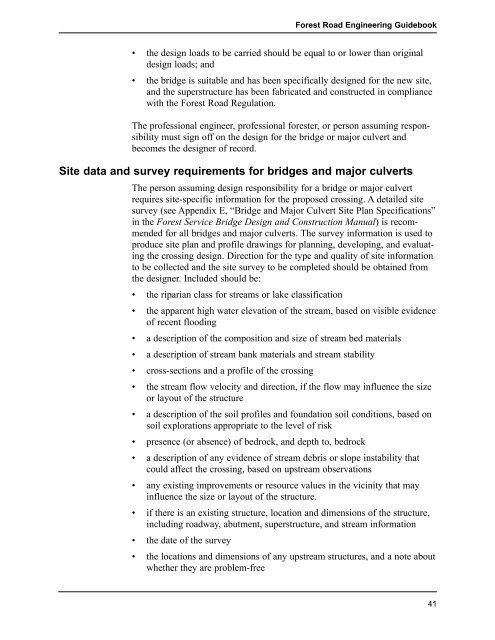Forest Road Engineering Guidebook - Ministry of Forests
Forest Road Engineering Guidebook - Ministry of Forests
Forest Road Engineering Guidebook - Ministry of Forests
Create successful ePaper yourself
Turn your PDF publications into a flip-book with our unique Google optimized e-Paper software.
<strong>Forest</strong> <strong>Road</strong> <strong>Engineering</strong> <strong>Guidebook</strong><br />
• the design loads to be carried should be equal to or lower than original<br />
design loads; and<br />
• the bridge is suitable and has been specifically designed for the new site,<br />
and the superstructure has been fabricated and constructed in compliance<br />
with the <strong>Forest</strong> <strong>Road</strong> Regulation.<br />
The pr<strong>of</strong>essional engineer, pr<strong>of</strong>essional forester, or person assuming responsibility<br />
must sign <strong>of</strong>f on the design for the bridge or major culvert and<br />
becomes the designer <strong>of</strong> record.<br />
Site data and survey requirements for bridges and major culverts<br />
The person assuming design responsibility for a bridge or major culvert<br />
requires site-specific information for the proposed crossing. A detailed site<br />
survey (see Appendix E, “Bridge and Major Culvert Site Plan Specifications”<br />
in the <strong>Forest</strong> Service Bridge Design and Construction Manual) is recommended<br />
for all bridges and major culverts. The survey information is used to<br />
produce site plan and pr<strong>of</strong>ile drawings for planning, developing, and evaluating<br />
the crossing design. Direction for the type and quality <strong>of</strong> site information<br />
to be collected and the site survey to be completed should be obtained from<br />
the designer. Included should be:<br />
• the riparian class for streams or lake classification<br />
• the apparent high water elevation <strong>of</strong> the stream, based on visible evidence<br />
<strong>of</strong> recent flooding<br />
• a description <strong>of</strong> the composition and size <strong>of</strong> stream bed materials<br />
• a description <strong>of</strong> stream bank materials and stream stability<br />
• cross-sections and a pr<strong>of</strong>ile <strong>of</strong> the crossing<br />
• the stream flow velocity and direction, if the flow may influence the size<br />
or layout <strong>of</strong> the structure<br />
• a description <strong>of</strong> the soil pr<strong>of</strong>iles and foundation soil conditions, based on<br />
soil explorations appropriate to the level <strong>of</strong> risk<br />
• presence (or absence) <strong>of</strong> bedrock, and depth to, bedrock<br />
• a description <strong>of</strong> any evidence <strong>of</strong> stream debris or slope instability that<br />
could affect the crossing, based on upstream observations<br />
• any existing improvements or resource values in the vicinity that may<br />
influence the size or layout <strong>of</strong> the structure.<br />
• if there is an existing structure, location and dimensions <strong>of</strong> the structure,<br />
including roadway, abutment, superstructure, and stream information<br />
• the date <strong>of</strong> the survey<br />
• the locations and dimensions <strong>of</strong> any upstream structures, and a note about<br />
whether they are problem-free<br />
41

















